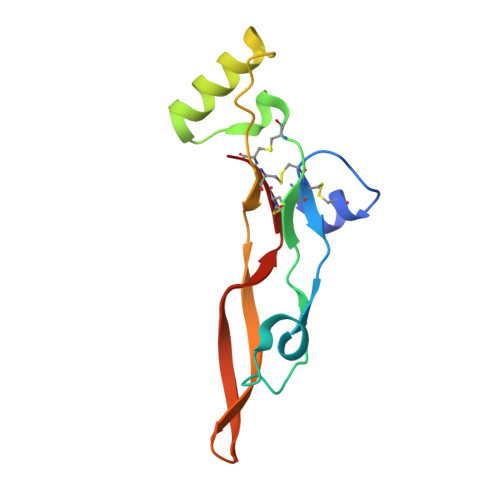Recombinant production, purification, crystallization, and structure analysis of human transforming growth factor beta 2 in a new conformation.
Del Amo-Maestro, L., Marino-Puertas, L., Goulas, T., Gomis-Ruth, F.X.(2019) Sci Rep 9: 8660-8660
- PubMed: 31209258
- DOI: https://doi.org/10.1038/s41598-019-44943-4
- Primary Citation of Related Structures:
6I9J - PubMed Abstract:
Transforming growth factor β is a disulfide-linked dimeric cytokine that occurs in three highly related isoforms (TGFβ1-TGFβ3) engaged in signaling functions through binding of cognate TGFβ receptors. To regulate this pathway, the cytokines are biosynthesized as inactive pro-TGFβs with an N-terminal latency-associated protein preceding the mature moieties. Due to their pleiotropic implications in physiology and pathology, TGFβs are privileged objects of in vitro studies. However, such studies have long been limited by the lack of efficient human recombinant expression systems of native, glycosylated, and homogenous proteins. Here, we developed pro-TGFβ2 production systems based on human Expi293F cells, which yielded >2 mg of pure histidine- or Strep-tagged protein per liter of cell culture. We assayed this material biophysically and in crystallization assays and obtained a different crystal form of mature TGFβ2, which adopted a conformation deviating from previous structures, with a distinct dimeric conformation that would require significant rearrangement for binding of TGFβ receptors. This new conformation may be reversibly adopted by a certain fraction of the mature TGβ2 population and represent a hitherto undescribed additional level of activity regulation of the mature growth factor once the latency-associated protein has been separated.
- Proteolysis Lab; Structural Biology Unit; "María-de-Maeztu" Unit of Excellence, Molecular Biology Institute of Barcelona (CSIC); Barcelona Science Park, c/Baldiri Reixac, 15-21, 08028, Barcelona, Catalonia, Spain.
Organizational Affiliation:
















